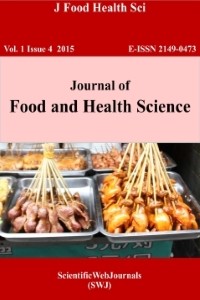GÜNLÜK AĞACI (Liquidambar orientalis) YAPRAKLARINDAN ELDE EDİLEN EKSTRAKTIN KÜLTÜR LEVREĞİNİN (Dicentrarchus labrax) RAF ÖMRÜ VE ET KALİTESİ ÜZERİNE ETKİSİ
Abstract
Bu
çalışmada Muğla (Türkiye) ilindeki endemik ağaç türlerinden biri olan günlük
ağacı yapraklarından elde edilen ekstraktın, kültür levreğinin kalitesi ve raf
ömrü üzerine doğal bir koruyucu olarak etkisinin tespit edilmesi amaçlanmıştır.
Bu amaçla kurutulduktan sonra ekstrakte edilmiş olan günlük ağacı
yapraklarından %0.1, %0.5 ve %1’lik oranlarda hazırlanan solüsyonlar içerisine
levrek balıkları daldırılmış ve buzdolabı şartlarında (4±2°C) kalite
değişimleri ve raf ömrü tespit edilmiştir. Kalite analizleri sonucunda duyusal
olarak kontrol grubu örneklerinin 15. günde, günlük ağacı yaprak ekstraktı
içeren bütün grupların ise 18. günden sonra bozulduğu tespit edilmiştir. Özellikle oksidasyon göstergesi olan TBA açısından ektraksiyon grupları
ile kontrol grubu arasında önemli bir fark bulunurken, mikrobiyolojik açıdan
önemli bir fark yakalanamasa da %1 günlük ağacı yaprak ekstraktının özellikle
toplam Enterobacteriaceae açısından
diğer gruplara oranla daha etkili olduğu görülmüştür. Çalışma sonunda sığla ekstraktı uygulanan levrek
balıklarının raf ömrünün duyusal olarak kontrol grubuna oranla 3 gün daha fazla
olduğu görülmüştür.
Keywords
Günĺük Ağacı Liquidambar orientalis Antioksidan Antimikrobiyal Levrek balığı Dicentrarchus labrax
References
- Abou-Taleb, M., El-Sherif, S.A., Elhariry, H. (2007): Preservation effect of four plant extracts used to extending the shelf-life of mullet fish fillets during cold storage. World Journal of Dairy & Food Sciences, 2: 74-82.
- Antonocopoulus, N. (1973): Bestimmung des Fl_chtigen Basenstickstoofs. In: Ludorf W, Meyer V, Fische und Fischerzeugnisse. Aulage Verlag Paul Parey, Berlin, pp. 224–225.
- AOAC (2002): Protein content in meat 928.08. Official Method of Analysis (17th ed.). Gaithersburg, Maryland: Association of Official Analytical Chemists.
- Aubourg, S.P. (2001): Chilled storage of horse mackarel. Journal of The American Oil Chemists Society, 78(8), 857-862.
- Baygar, T. (1999) Ton Balıklarının (Katsuwonus pelamis, L. 1758) Konserveye İşlenmesi Sırasında Besin içeriği ve Kalitesinde Meydana Gelen Değişimlerin Belirlenmesi. İstanbul Üniversitesi Fen Bililmleri Enstitüsü Doktora Tezi. İstanbul.
- Baytop, T. (1984): Therapy with Medicinal Plants in Turkey (Post and Present). İstanbul University Publication No. 3255, İstanbul.
- Bligh, E.G., Dyer, W.J. (1959): A rapid method of total lipit extraction and proficiation. Canadian Journal of Biochemistry and Physiology, 37: 911-917.
- Bonnell, A.D. (1994): Quality assurance in seafood processing: a practical guide. Chapman and Hall, London, p:74-75.
- Çetinkaya, A. (2011): Timol, karvakrol, eugenol ve alfa terpineol'un soğukta depolanan vakum paketlenmiş hamsi filetoları üzerine etkilerinin incelenmesi. Doktora Tezi Çukurova Üniversitesi, Adana, 114s.
- EC. (1995): Commission Decision fixing the total volatile basic nitrogen (TVB-N) limit values for certain categories of fishery products and specifying the analysis methods tu be used, Official Journal of the European Communities 95/149.
- El-Hanafy, A.E.A., Shawky, H.A., Ramadan M.F. (2010): Preservation of Oreochromis niloticus fish using frozen green tea extract: ımpact on biochemical, microbiological and sensory characteristics. Journal Of Food Processing And Preservation, 639-648.
- FAO (1986): FAO Food and Nutrition Paper Manuals of Food Quality Control Food Analysis: Quality, Adulteration and Tests of Identity. Food and Agriculture Organization of the United Nations, Rome.
- FDA/BAM (2001): Aerobic plate count. Food and drug analyses/bacteriological analytical manual 8 Edition, Chapter 3.
- Frangos, L., Pyrgotou, N., Giatrakou, V., Ntzimani, A., Savvaidis, I.N. (2010): Combined effects of salting, oregano oil and vacuumpackaging on the shelf-life of refrigerated trout fillets. Food Microbiology, 27 p: 115–121.
- Gallo, M., Ferracane, R., Naviglio, D. (2012): Antioxidant addition to prevent lipid and protein oxidation in chicken meat mixed with supercritical extracts of Echinacea angustifolia. Journal of Supercritical Fluids, 72, 198-204.
- Hafızoglu, H. (1982). Analytical studies on the balsam of Liquidambar orientalis Mill. by gas chromatography and mass spectrometry. Holzforschung, 36: 311-313.
- Hafızoglu, H., Reunanen, M., Istek, A. (1996) Chemical composition of levant storax. Holzforschung, 50: 116-117.
- ICMSF (International Commission on Microbiological Specification for Food), (1986): Microorganisms in Foods. In Elliott, R. P., Clark, D. S., Lewis, K. H.. Lundbeck, H., Olsen, J. C., Simonsen, J. B. (Eds.), Their Significance and Method of Enumeration 2nd ed, Vol. 1, University of Toronto Pres, London.
- ICMSF 1986. Microorganisms in Foods. 2. Sampling For Microbiological Analysis: Principles and Specific Applications, 2nd ed. University of Toronto Press, Buffalo, NY.
- İbrahim, S.M., El-Sherif, S.A. (2008): Effects of some plants extracts on quality aspects of frozen tilapia (Oreochromis niloticus l.) fillets. Global Veterinaria, 2: 62-66.
- İstek, A., Hafızoğlu, H. (2005) Sığla Ağacı (Liquidambar orientalis Mill.) Odunu Kabuğunun Kimyasal Bileşenleri, Gazi Üniversitesi Orman Fakültesi Dergisi, 5(1): 1-5.
- Kenar, M. (2009): Aromatik bitkilerden elde edilen doğal antioksidanların balık filetosu üzerindeki duyusal, kimyasal ve mikrobiyolojik etkilerinin incelenmesi. Yüksek Lisans Tezi Çukurova Üniversitesi Adana.
- Manthey, M., Karnop, G., Rehbein, H. (1988): Quality changes of european catfish (Silurus glanis) from worm-water aquaculture during storage ıce. International Journal of Food Science and Technology, 23: 1-9.
- Özyurt, G., Özkütük, A.S., Polat, A. (2010): Capability of the rosemary (Rosmarinus officinalis) extract on the oxidative stability of cooked sea bream (Sparus aurata) during frozen storage. Journal für Verbrauchershutz und Lebensmittelsicherheit, 6: 167-174.
- Pezeshk, S., Hosseini, H., Rezaei, M., Khaksar, R. (2012): Evaluation of shelf life of live and gutted fish treated with a shallot extract. Journal of Food Processing and Preservation, 1745-4549.
- Sağdıç, O., Telli, R., Akkaya, L., Yetim, H. (2008): Kekik ekstraktının köftede antimikrobiyal, antioksidan ve duyusal etkileri. Türkiye 10. Gıda Kongresi, 21-23 Mayıs 2008, Erzurum, 547.
- Schormüller, J. (1968): Handbuch der lebensmittel chemie. Band III/2 Teil. Tierische Lebensmittel Eier, Fleisch, Fisch, Buttermilch. Springer-Verlag. pp. 1341-1392.
- Serdaroğlu, M., Barış, P. (2012): Et ve et ürünlerinde biyokoruyucuların kullanımı. Gıda Teknolojisi Haber, http://www.gidateknolojisi.com.tr/haber, E.T: 10.12.2013.
- Tarladgis, B.G., Watts, B.M., Yonathan M. (1960): Distillation method for the determination of malonaldehyde in rancid foods. Journal of The American Oil Chemists Society, 37(1): 44-48.
- Yerlikaya, P., Gökoğlu N. (2009): Effects ofprevious plant extract treatment on seonsory and physical properties of frozen bonito (Sarda sarda) fillets. Turkish Journal of Fisheries and Aquatic Sciences, 10: 341-349.
DETERMINATION OF THE EFFECTS OF SWEETGUM EXTRACT OBTAINED FROM INCENSE TREE (Liquidambar orientalis) ON THE SHELF LIFE AND QUALITY OF CULTURED SEA BASS (Dicentrarc¬hus labrax)
Abstract
This study aim to establish effect of extract, obtained from leaves of
incense tree, an endemic and relict tree species in Muğla (Turkey), as natural
preservative on quality and shelf life of the culture sea bass. For this purpose, after a solution was prepared in a ratio of 0.1%, 0.5% and 1% from the leaves of
incense tree that has been extracted
after drying, sea bass submerged into
this solutions and quality changes
and shelf life was determined at
refrigerator conditions (4±2°C). As a result of the quality analysis, control
group samples got spoilt at 15th day
in terms of sensory, whereas all the groups, consisting
of leaf extract of incense tree, were found to deteriorate after 18
days. While there were significant difference especially
in oxidation index; TBA between control group and groups with the extraction, not an
important difference could be found in terms of microbiology. Nevertheless 1%
extract solution was more effective over Enterobacteriaceae compared
to the other groups. At the end of the study, it
was observed that shelf life of sea bass with sweetgum extract was 3 days more
than the shelf life of the control group in sensorial way.
Keywords
Incense Tree Liquidambar orientalis Antioxidant Antimicrobial Sea bass Dicentrarchus labrax
References
- Abou-Taleb, M., El-Sherif, S.A., Elhariry, H. (2007): Preservation effect of four plant extracts used to extending the shelf-life of mullet fish fillets during cold storage. World Journal of Dairy & Food Sciences, 2: 74-82.
- Antonocopoulus, N. (1973): Bestimmung des Fl_chtigen Basenstickstoofs. In: Ludorf W, Meyer V, Fische und Fischerzeugnisse. Aulage Verlag Paul Parey, Berlin, pp. 224–225.
- AOAC (2002): Protein content in meat 928.08. Official Method of Analysis (17th ed.). Gaithersburg, Maryland: Association of Official Analytical Chemists.
- Aubourg, S.P. (2001): Chilled storage of horse mackarel. Journal of The American Oil Chemists Society, 78(8), 857-862.
- Baygar, T. (1999) Ton Balıklarının (Katsuwonus pelamis, L. 1758) Konserveye İşlenmesi Sırasında Besin içeriği ve Kalitesinde Meydana Gelen Değişimlerin Belirlenmesi. İstanbul Üniversitesi Fen Bililmleri Enstitüsü Doktora Tezi. İstanbul.
- Baytop, T. (1984): Therapy with Medicinal Plants in Turkey (Post and Present). İstanbul University Publication No. 3255, İstanbul.
- Bligh, E.G., Dyer, W.J. (1959): A rapid method of total lipit extraction and proficiation. Canadian Journal of Biochemistry and Physiology, 37: 911-917.
- Bonnell, A.D. (1994): Quality assurance in seafood processing: a practical guide. Chapman and Hall, London, p:74-75.
- Çetinkaya, A. (2011): Timol, karvakrol, eugenol ve alfa terpineol'un soğukta depolanan vakum paketlenmiş hamsi filetoları üzerine etkilerinin incelenmesi. Doktora Tezi Çukurova Üniversitesi, Adana, 114s.
- EC. (1995): Commission Decision fixing the total volatile basic nitrogen (TVB-N) limit values for certain categories of fishery products and specifying the analysis methods tu be used, Official Journal of the European Communities 95/149.
- El-Hanafy, A.E.A., Shawky, H.A., Ramadan M.F. (2010): Preservation of Oreochromis niloticus fish using frozen green tea extract: ımpact on biochemical, microbiological and sensory characteristics. Journal Of Food Processing And Preservation, 639-648.
- FAO (1986): FAO Food and Nutrition Paper Manuals of Food Quality Control Food Analysis: Quality, Adulteration and Tests of Identity. Food and Agriculture Organization of the United Nations, Rome.
- FDA/BAM (2001): Aerobic plate count. Food and drug analyses/bacteriological analytical manual 8 Edition, Chapter 3.
- Frangos, L., Pyrgotou, N., Giatrakou, V., Ntzimani, A., Savvaidis, I.N. (2010): Combined effects of salting, oregano oil and vacuumpackaging on the shelf-life of refrigerated trout fillets. Food Microbiology, 27 p: 115–121.
- Gallo, M., Ferracane, R., Naviglio, D. (2012): Antioxidant addition to prevent lipid and protein oxidation in chicken meat mixed with supercritical extracts of Echinacea angustifolia. Journal of Supercritical Fluids, 72, 198-204.
- Hafızoglu, H. (1982). Analytical studies on the balsam of Liquidambar orientalis Mill. by gas chromatography and mass spectrometry. Holzforschung, 36: 311-313.
- Hafızoglu, H., Reunanen, M., Istek, A. (1996) Chemical composition of levant storax. Holzforschung, 50: 116-117.
- ICMSF (International Commission on Microbiological Specification for Food), (1986): Microorganisms in Foods. In Elliott, R. P., Clark, D. S., Lewis, K. H.. Lundbeck, H., Olsen, J. C., Simonsen, J. B. (Eds.), Their Significance and Method of Enumeration 2nd ed, Vol. 1, University of Toronto Pres, London.
- ICMSF 1986. Microorganisms in Foods. 2. Sampling For Microbiological Analysis: Principles and Specific Applications, 2nd ed. University of Toronto Press, Buffalo, NY.
- İbrahim, S.M., El-Sherif, S.A. (2008): Effects of some plants extracts on quality aspects of frozen tilapia (Oreochromis niloticus l.) fillets. Global Veterinaria, 2: 62-66.
- İstek, A., Hafızoğlu, H. (2005) Sığla Ağacı (Liquidambar orientalis Mill.) Odunu Kabuğunun Kimyasal Bileşenleri, Gazi Üniversitesi Orman Fakültesi Dergisi, 5(1): 1-5.
- Kenar, M. (2009): Aromatik bitkilerden elde edilen doğal antioksidanların balık filetosu üzerindeki duyusal, kimyasal ve mikrobiyolojik etkilerinin incelenmesi. Yüksek Lisans Tezi Çukurova Üniversitesi Adana.
- Manthey, M., Karnop, G., Rehbein, H. (1988): Quality changes of european catfish (Silurus glanis) from worm-water aquaculture during storage ıce. International Journal of Food Science and Technology, 23: 1-9.
- Özyurt, G., Özkütük, A.S., Polat, A. (2010): Capability of the rosemary (Rosmarinus officinalis) extract on the oxidative stability of cooked sea bream (Sparus aurata) during frozen storage. Journal für Verbrauchershutz und Lebensmittelsicherheit, 6: 167-174.
- Pezeshk, S., Hosseini, H., Rezaei, M., Khaksar, R. (2012): Evaluation of shelf life of live and gutted fish treated with a shallot extract. Journal of Food Processing and Preservation, 1745-4549.
- Sağdıç, O., Telli, R., Akkaya, L., Yetim, H. (2008): Kekik ekstraktının köftede antimikrobiyal, antioksidan ve duyusal etkileri. Türkiye 10. Gıda Kongresi, 21-23 Mayıs 2008, Erzurum, 547.
- Schormüller, J. (1968): Handbuch der lebensmittel chemie. Band III/2 Teil. Tierische Lebensmittel Eier, Fleisch, Fisch, Buttermilch. Springer-Verlag. pp. 1341-1392.
- Serdaroğlu, M., Barış, P. (2012): Et ve et ürünlerinde biyokoruyucuların kullanımı. Gıda Teknolojisi Haber, http://www.gidateknolojisi.com.tr/haber, E.T: 10.12.2013.
- Tarladgis, B.G., Watts, B.M., Yonathan M. (1960): Distillation method for the determination of malonaldehyde in rancid foods. Journal of The American Oil Chemists Society, 37(1): 44-48.
- Yerlikaya, P., Gökoğlu N. (2009): Effects ofprevious plant extract treatment on seonsory and physical properties of frozen bonito (Sarda sarda) fillets. Turkish Journal of Fisheries and Aquatic Sciences, 10: 341-349.
Details
| Journal Section | Articles |
|---|---|
| Authors | |
| Publication Date | July 20, 2015 |
| Submission Date | April 15, 2015 |
| Published in Issue | Year 2015Volume: 1 Issue: 4 |
Cite
Journal is licensed under a
CreativeCommons Attribtion-ShareAlike 4.0 International Licence 


Diamond Open Access refers to a scholarly publication model in which journals and platforms do not charge fees to either authors or readers.
Open Access Statement:
This is an open access journal which means that all content is freely available without charge to the user or his/her institution. Users are allowed to read, download, copy, distribute, print, search, or link to the full texts of the articles, or use them for any other lawful purpose, without asking prior permission from the publisher or the author. This is in accordance with the BOAI definition of open access.
Archiving Policy:
Archiving is done according to ULAKBİM "DergiPark" publication policy (LOCKSS).


